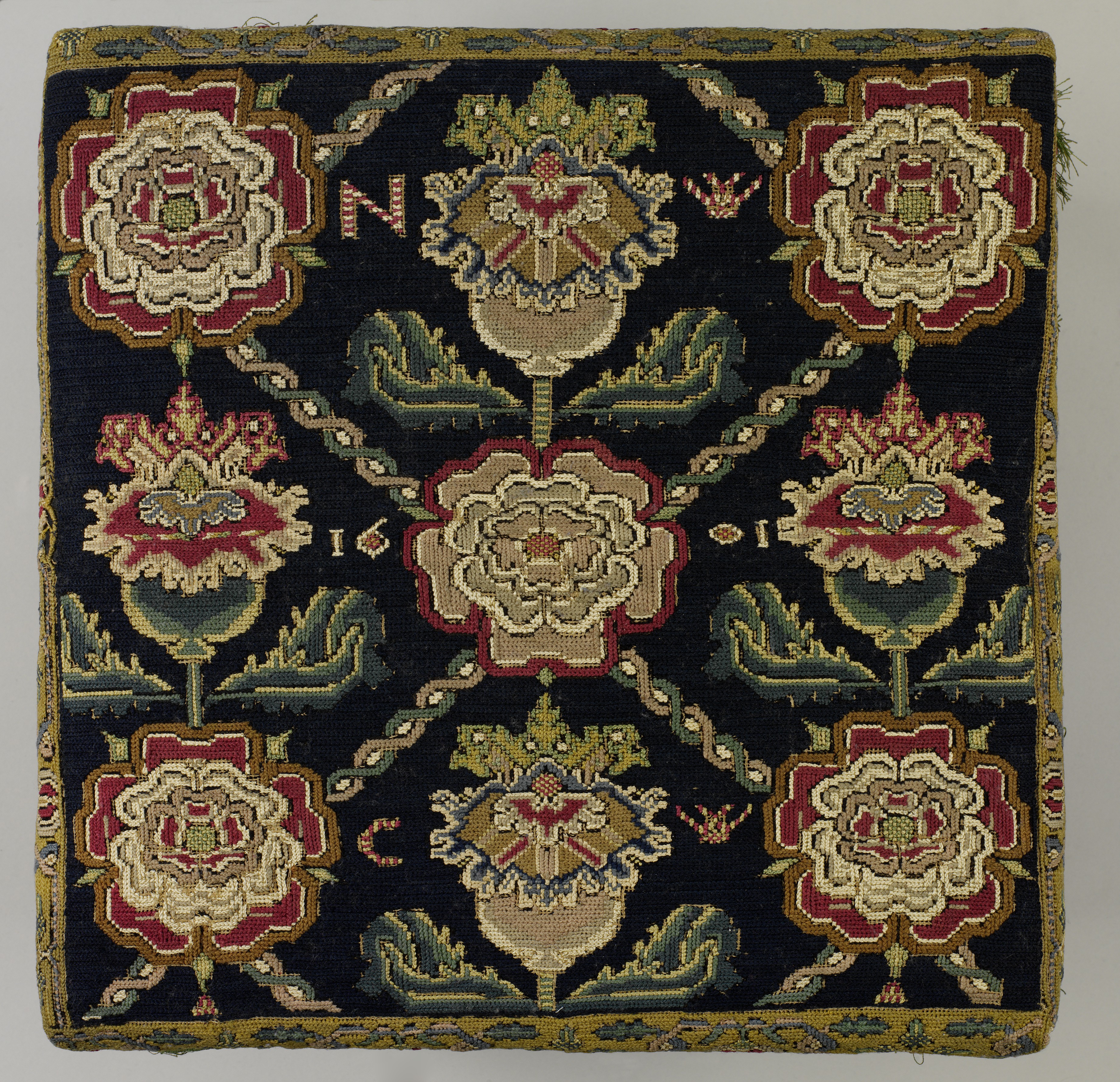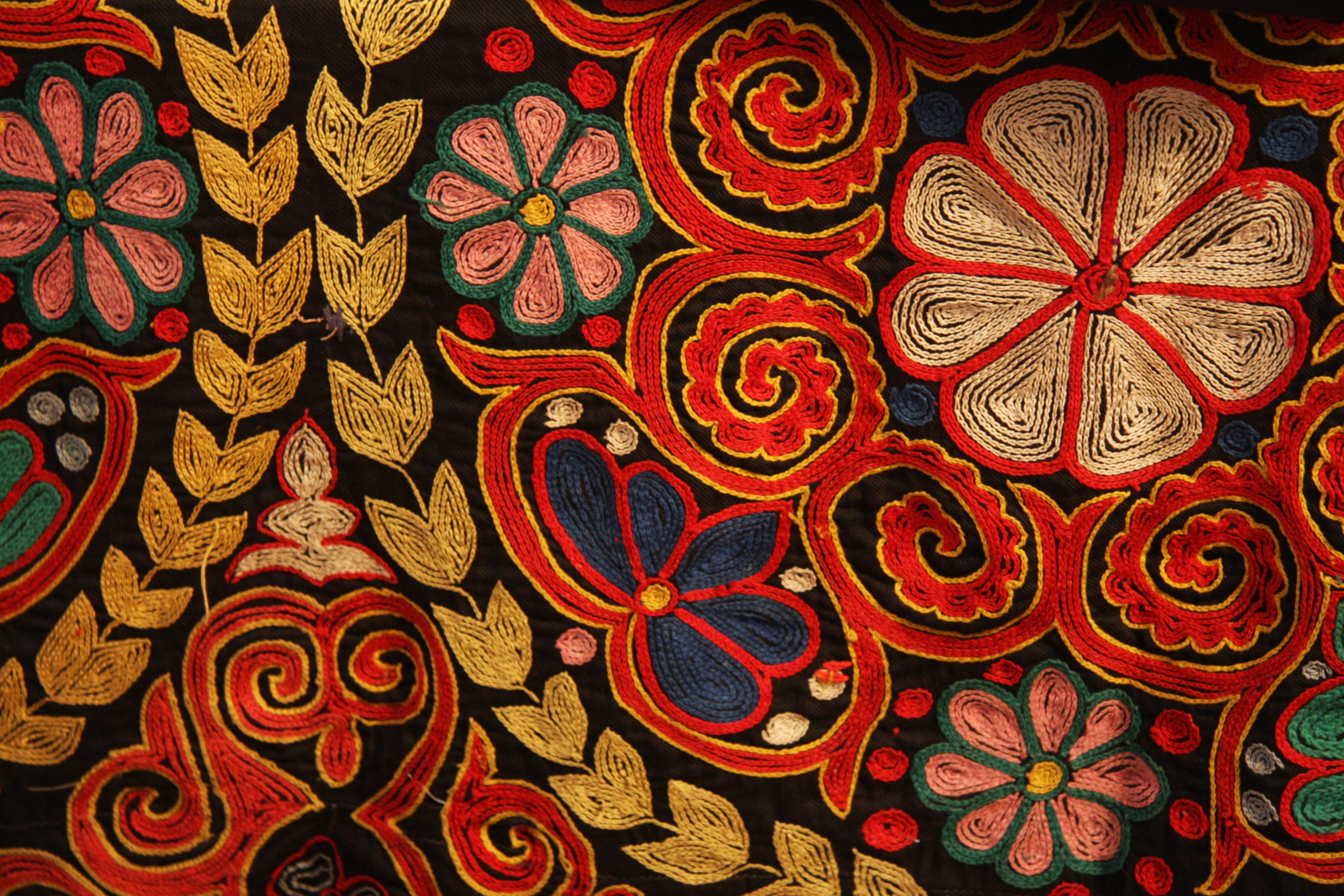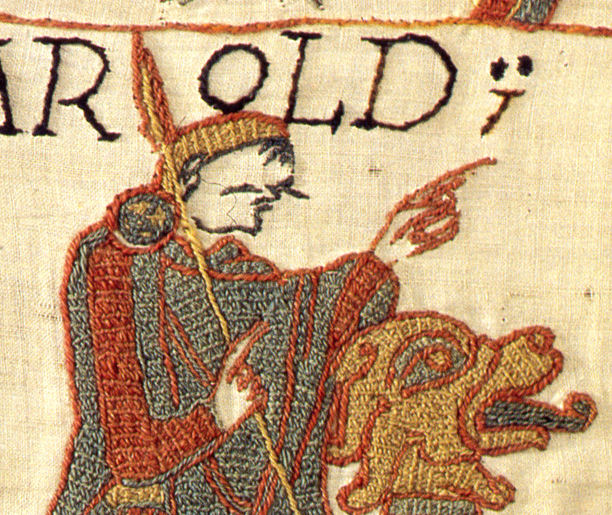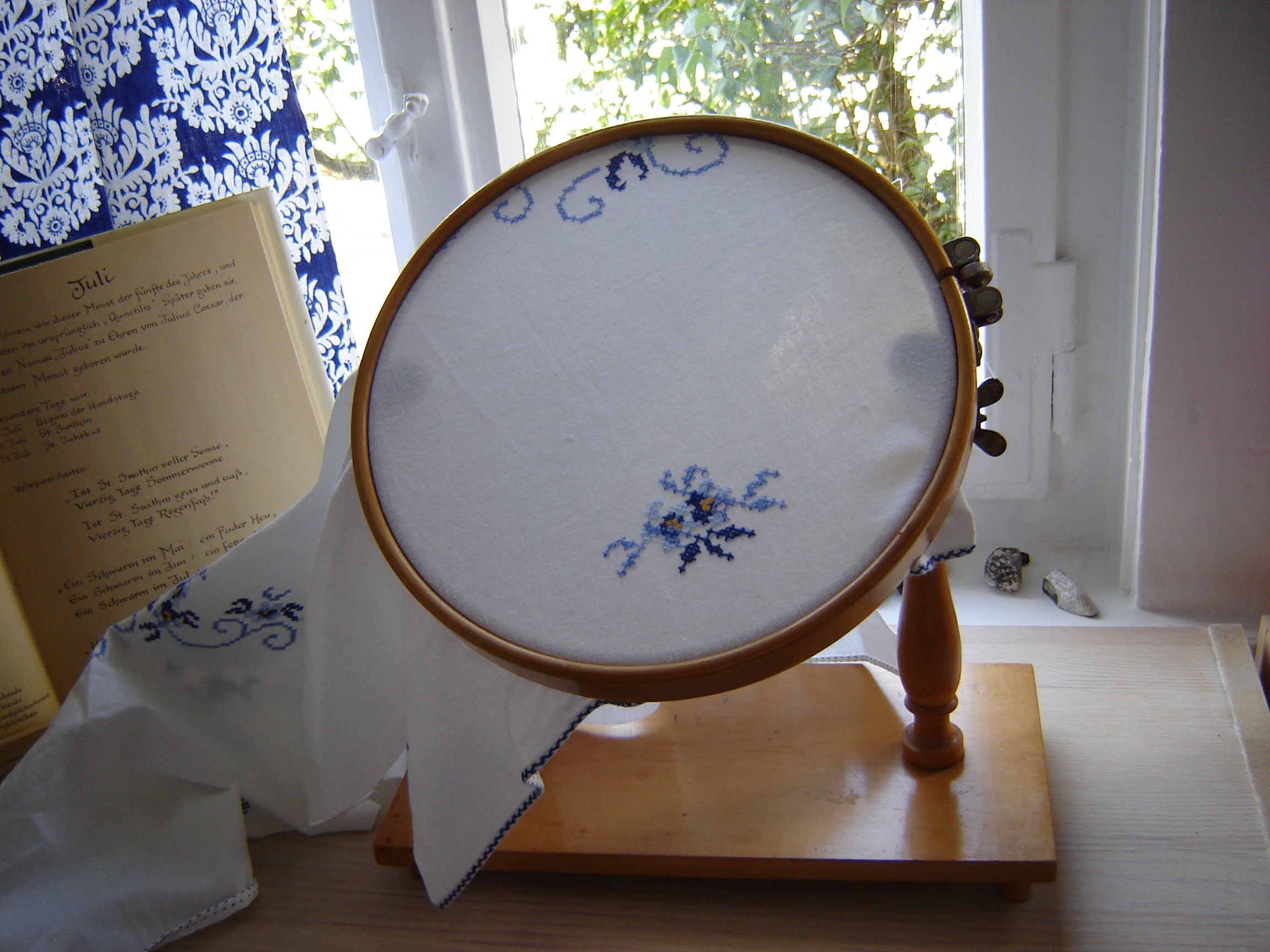|
Crewelwork
Crewel embroidery, or crewelwork, is a type of surface embroidery using wool. A wide variety of different embroidery stitches are used to follow a design outline applied to the fabric. The technique is at least a thousand years old. Crewel embroidery is not identified with particular styles of designs, but rather is embroidery with the use of this wool thread. Modern crewel wool is a fine, two-ply or one-ply yarn available in many different colours. Crewel embroidery is often associated with England in the 17th and 18th centuries, and from England was carried to the American colonies. It was particularly popular in New England. The stitches and designs used in America were simpler and more economical with the scarce crewel wool. The Deerfield Society of Blue and White Needlework (1896–1926) revived interest in crewel embroidery in the United States. Description of the technique The crewel technique is not a counted-thread embroidery (like canvas work), but a style of free ... [...More Info...] [...Related Items...] OR: [Wikipedia] [Google] [Baidu] |
Crewel Curtain C 1696 England Leaf Detail
Crewel embroidery, or crewelwork, is a type of surface embroidery using wool. A wide variety of different embroidery stitches are used to follow a design outline applied to the fabric. The technique is at least a thousand years old. Crewel embroidery is not identified with particular styles of designs, but rather is embroidery with the use of this wool thread. Modern crewel wool is a fine, two-ply or one-ply yarn available in many different colours. Crewel embroidery is often associated with England in the 17th and 18th centuries, and from England was carried to the American colonies. It was particularly popular in New England. The stitches and designs used in America were simpler and more economical with the scarce crewel wool. The Deerfield Society of Blue and White Needlework (1896–1926) revived interest in crewel embroidery in the United States. Description of the technique The crewel technique is not a counted-thread embroidery (like canvas work), but a style of free ... [...More Info...] [...Related Items...] OR: [Wikipedia] [Google] [Baidu] |
Chain Stitch
Chain stitch is a sewing and embroidery technique in which a series of looped stitches form a chain-like pattern. Chain stitch is an ancient craft – examples of surviving Chinese chain stitch embroidery worked in silk thread have been dated to the Warring States period (5th – 3rd century BC). Handmade chain stitch embroidery does not require that the needle pass through more than one layer of fabric. For this reason the stitch is an effective surface embellishment near seams on finished fabric. Because chain stitches can form flowing, curved lines, they are used in many surface embroidery styles that mimic "drawing" in thread. Chain stitches are also used in making tambour lace, needlelace, macramé and crochet. In Azerbaijan, in the Sheki region, this ancient type of needlework is called tekeldus. History The earliest archaeological evidence of chain stitch embroidery dates from 1100 BC in China. Excavated from royal tombs, the embroidery was made using threads of silk. ... [...More Info...] [...Related Items...] OR: [Wikipedia] [Google] [Baidu] |
Embroidery
Embroidery is the craft of decorating fabric or other materials using a needle to apply thread or yarn. Embroidery may also incorporate other materials such as pearls, beads, quills, and sequins. In modern days, embroidery is usually seen on caps, hats, coats, overlays, blankets, dress shirts, denim, dresses, stockings, scarfs, and golf shirts. Embroidery is available in a wide variety of thread or yarn colour. Some of the basic techniques or stitches of the earliest embroidery are chain stitch, buttonhole or blanket stitch, running stitch, satin stitch, and cross stitch. Those stitches remain the fundamental techniques of hand embroidery today. History Origins The process used to tailor, patch, mend and reinforce cloth fostered the development of sewing techniques, and the decorative possibilities of sewing led to the art of embroidery. Indeed, the remarkable stability of basic embroidery stitches has been noted: The art of embroidery has been found worldwide and ... [...More Info...] [...Related Items...] OR: [Wikipedia] [Google] [Baidu] |
Jacobean Embroidery
Jacobean embroidery refers to embroidery styles that flourished in the reign of King James I of England in first quarter of the 17th century. The term is usually used today to describe a form of crewel embroidery used for furnishing characterized by fanciful plant and animal shapes worked in a variety of stitches with two-ply wool yarn on linen. Popular motifs in Jacobean embroidery, especially curtains for bed hangings, are the Tree of Life and stylized forests, usually rendered as exotic plants arising from a landscape or ''terra firma'' with birds, stags, squirrels, and other familiar animals.Christie, Grace: ''Embroidery and Tapestry Weaving'', London 1912 Origins Early Jacobean embroidery often featured scrolling floral patterns worked in colored silks on linen, a fashion that arose in the earlier Elizabethan era. Embroidered jackets were fashionable for both men and women in the period 1600-1620, and several of these jackets have survived. Designs Often based on tree ... [...More Info...] [...Related Items...] OR: [Wikipedia] [Google] [Baidu] |
Backstitch
Backstitch or ''back stitch'' and its variants ''stem stitch'', ''outline stitch'' and ''split stitch'' are a class of embroidery and sewing stitches in which individual stitches are made backward to the general direction of sewing. In embroidery, these stitches form lines and are most often used to outline shapes and to add fine detail to an embroidered picture. It is also used to embroider lettering. In hand sewing, it is a utility stitch which strongly and permanently attaches two pieces of fabric. The small stitches done back-and-forth makes the back stitch the strongest stitch among the basic stitches. Hence it can be used to sew strong seams by hand, without a sewing machine. How to do it A versatile stitch which is easy to work, backstitch is ideal for following both simple and intricate outlines and as a foundation row for more complex embroidery stitches such as ''herringbone ladder filling stitch''. Although superficially similar to the Holbein stitch, which is comm ... [...More Info...] [...Related Items...] OR: [Wikipedia] [Google] [Baidu] |
Norman Conquest Of England
The Norman Conquest (or the Conquest) was the 11th-century invasion and occupation of England by an army made up of thousands of Normans, Norman, Duchy of Brittany, Breton, County of Flanders, Flemish, and Kingdom of France, French troops, all led by the Duke of Normandy, later styled William the Conqueror. William's claim to the English throne derived from his familial relationship with the childless Anglo-Saxon king Edward the Confessor, who may have encouraged William's hopes for the throne. Edward died in January 1066 and was succeeded by his brother-in-law Harold Godwinson. The Norwegian king Harald Hardrada invaded northern England in September 1066 and was victorious at the Battle of Fulford on 20 September, but Godwinson's army defeated and killed Hardrada at the Battle of Stamford Bridge on 25 September. Three days later on 28 September, William's invasion force of thousands of men and hundreds of ships landed at Pevensey in Sussex in southern England. Harold march ... [...More Info...] [...Related Items...] OR: [Wikipedia] [Google] [Baidu] |
Worsted
Worsted ( or ) is a high-quality type of wool yarn, the fabric made from this yarn, and a yarn weight category. The name derives from Worstead, a village in the English county of Norfolk. That village, together with North Walsham and Aylsham, formed a manufacturing centre for yarn and cloth in the 12th century, when pasture enclosure and liming rendered the East Anglian soil too rich for the older agrarian sheep breeds. In the same period, many weavers from the County of Flanders moved to Norfolk. "Worsted" yarns/fabrics are distinct from woollens (though both are made from sheep's wool): the former is considered stronger, finer, smoother, and harder than the latter. Worsted was made from the long-staple pasture wool from sheep breeds such as Teeswaters, Old Leicester Longwool and Romney Marsh. Pasture wool was not carded; instead it was washed, gilled and combed (using heated long-tooth metal combs), oiled and finally spun. When woven, worsteds were scoured but not fulled. ... [...More Info...] [...Related Items...] OR: [Wikipedia] [Google] [Baidu] |
Embroidery Hoop
Embroidery hoops and frames are tools used to keep fabric taut while working embroidery or other forms of needlework. Hoops An embroidery hoop or (earlier) tambour frame consists of a pair of concentric circular or elliptical rings. The larger ring has a tightening device, usually in the form of a metal screw. The artisan repositions the hoop as needed when working over a large piece of fabric. Embroidery hoops come in various sizes and are generally small enough to control with one hand and rest in the lap. Hoops were originally made of wood, bone, or ivory;Christie, Grace: ''Embroidery and Tapestry Weaving'', London, John Hogg, 1912 modern hoops are made of wood or plastic.Reader's Digest ''Complete Guide to Needlework''. The Reader's Digest Association, Inc. (March 1992). , p. 10 Hoops may be attached to a table-top or floor stand when both hands must be free for sewing, as in making tambour lace. Standing floor frames and lap frames allow the crafter to keep both hands ... [...More Info...] [...Related Items...] OR: [Wikipedia] [Google] [Baidu] |
Bed Hangings
Bed hangings or bed curtains are fabric panels that surround a bed; they were used from medieval times through to the 19th century. Bed hangings provided privacy when the master or great bed was in a public room, such as the parlor. They also kept warmth in, and were a way of showing one's wealth. When bedrooms became more common in the mid-1700s, the use of bed hangings diminished. Bed hangings were made of various fabrics, depending on the place, time period, and wealth of the owner. Fabrics included wool, cotton, linen, fustian, and, for those who could afford it, silk or velvet. Stitches were worked in wool or, for the rich or the nobility, silk and gold. Decorations on bed hangings also varied based on geography and time period. French hangings during the Renaissance might depict embroidered scenes from the Bible, mythology, or allegory. Hangings from the UK used floral, leaf, chinoiserie, and animal themes at various times, and those from the American Colonies often followed ... [...More Info...] [...Related Items...] OR: [Wikipedia] [Google] [Baidu] |
French Knot
A knotted stitch, also known as knot stitch, is any embroidery technique in which the yarn or thread is knotted around itself. A knotted stitch is a type of decorative embroidery stitches which form three-dimensional knots on the surface of a textile. Common knotted stitches include French knots, coral stitch,Enthoven, Jacqueline: ''The Creative Stitches of Embroidery'', Van Norstrand Rheinhold, 1964, , p. 153-163Reader's Digest ''Complete Guide to Needlework''. The Reader's Digest Association, Inc. (March 1992). , p. 42-43 and Pekin knot (also known as Forbidden stitch, Pekin stitch, and seed stitch) which is sometimes also referred as French knot although there is a difference in techniques between these two stitches. Knotted stitches can be subdivided into individual or detached knots, continuous knotted stitches, and knotted edgings. History Knotted embroidery originated in ancient China; the oldest example of it dates from the Warring States period in the form a pair of s ... [...More Info...] [...Related Items...] OR: [Wikipedia] [Google] [Baidu] |
Seed Stitch
Basic knitted fabrics include stocking stitch, reverse stocking stitch, garter stitch, seed stitch, faggoting, and tricot. In some cases, these fabrics appear differently on the right side (as seen when making the stitch) than on the wrong side (as seen from the other side, when the work is turned). Stockinette/stocking stitch and reverse stockinette stitch Stocking stitch (in US, stockinette stitch) is the most basic knitted fabric; every stitch (as seen from the right side) is a knit stitch. In the round, stocking stitch is produced by knitting every stitch; by contrast, in the flat, stocking stitch is produced by knitting and purling alternate rows. Stocking-stitch fabric is very smooth and each column ("wale") resembles a stacked set of "V"'s. It has a strong tendency to curl horizontally and vertically because of the asymmetry of its faces. Reverse stocking stitch is produced in the same way as stocking, except that the purl stitches are done on the right side and the kn ... [...More Info...] [...Related Items...] OR: [Wikipedia] [Google] [Baidu] |







.jpg)
